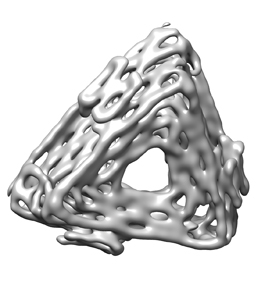Inventing Nanomachines Powered by Nature

A cryo-electron micrograph of DNA designed to assemble into a virus trap. (Image obtained by Daichi Hayakawa, PhD’22, and Ben Rogers, assistant professor of physics.)
by Lawrence Goodman
A means of self-healing wounds and a cure for viral infectious diseases are two of the big projects being developed at Brandeis’ Materials Research Science and Engineering Center (MRSEC).
If these inventions sound like the stuff of science fiction, says MRSEC director and professor of physics Seth Fraden, “the science is there. This is going to happen.”
The National Science Foundation agrees. In July, the Brandeis MRSEC landed its third multimillion-dollar grant, one of only 11 universities nationally to receive this NSF funding. The six-year $18 million award will enable the center to continue the cutting-edge research begun in 2008, when it won its first grant.
The Brandeis MRSEC focuses on “soft matter” — compounds like gels, liquid crystals, foams and polymers, which exist somewhere between a liquid and a solid state. Fraden and his colleagues aim to invent revolutionary new types of nano-sized materials and machines with powers and properties found in nature. By understanding such phenomena as the behavior of cellular proteins or starlings’ flight patterns, the researchers hope they can imbue synthetic compounds with biologically inspired abilities.
Consider their project to engineer new proteins for self-healing wounds. It starts with mysterious organisms called archaea. Classified as a completely separate life form, these single-celled organisms have been found in boiling geysers deep beneath the sea and share characteristics with human cells.
Researchers are interested in the proteins in archaea’s outer cell membranes. These proteins are capable of rearranging themselves, making archaeal cells wondrous shape-shifters, able to change into triangles, rods, circles and teardrops.
“They respond very fast and adapt into all different kinds of shapes and sizes,” says assistant professor of biology Alexandre Bisson, who is studying how these proteins could be harnessed to function in humans the way they do in archaea — to repair damaged cells. Specifically, Bisson is looking for ways to engineer and produce new proteins inspired by archaeal ones that could be injected into humans to heal tissues.
Another amazing power of biomolecules is their ability to self-assemble into elaborate three-dimensional structures on their own. Fraden and his collaborators have synthesized DNA to fold up into the shape of a pitcher plant, which is flute-shaped with an opening at the top. When flies enter the plant’s opening, they become stuck on the nectar inside and are then digested. A pitcher plant made of DNA will work the same way: A virus enters in the open top, gets trapped on the bottom by viral antibodies and is then digested by enzymes purposely planted there.
Brandeis is the smallest institution of the 11 NSF grant winners, and its MRSEC draws on the university’s distinctive academic approach. Scientists and students transcend programmatic, departmental and school affiliations to work across disciplines, in an approach Brandeis calls horizontal connectivity. Likewise, some 17 Brandeis faculty from six science departments work alongside 30 graduate students, postdocs, undergraduates and MRSEC staff — an example of vertical connectivity.
As part of the NSF’s Partnerships for Research and Education in Materials, the Brandeis MRSEC is also collaborating on research with Hampton University, a historically Black university in Virginia, through a six-year $3.6 million PREM grant, which aims to boost diversity in the sciences by building Hampton’s research capacity, and increasing the recruitment, retention and graduation rates of students from underrepresented groups.
